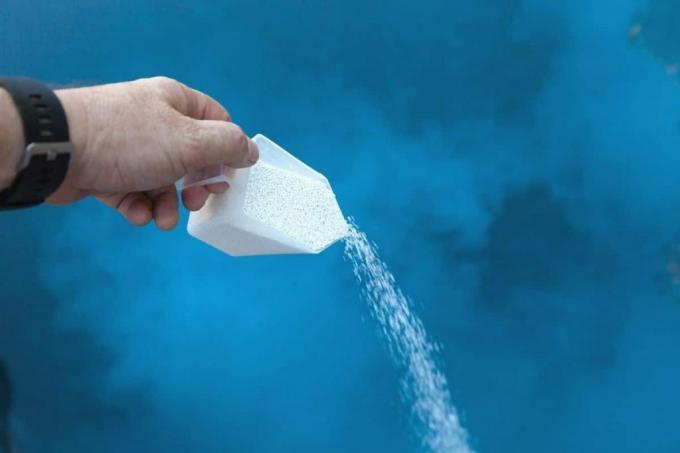
table of contents
- Cause of green pool water
- What is shock chlorination?
- Test pool water
- Instructions for shock chlorination
- Subsequent algae control & prevention
- frequently asked Questions
When the pool water turns green, bathing is no longer fun. It's time for a shock chlorination to combat the green pool water. Read here what needs to be considered and how it works.
In a nutshell
- the pool water turns green when the water values are no longer correct
- Testing is essential before adding chlorine
- certain pH values must be observed for clear water
- Perform shock chlorination regularly
Cause of green pool water
The water in the pool turns green when there are so many nutrients in it that the algae grow excessively. Algae can be found in almost any water because they only occur in spores and removing them completely is next to impossible. Keeping the number of algae below a visible limit is feasible with the right pool maintenance. This also includes shock chlorination, which is particularly used when the pool water is already green or cloudy.

Further reasons for performing shock chlorination:
- major changes in or around the pool that could lead to contamination
- for pools, with water level at ground level: Wild animals have fallen into the pool or have bathed in it
- very many users in a short time (pool party)
- very high temperatures or rapid temperature changes
- heavy rains, especially during thunderstorms
What is shock chlorination?
To keep the pool water clear, a little chlorine is always added to the water. It suppresses microorganisms and eliminates bacteria. With shock chlorination, however, the amount of chlorine is increased so that the chlorination is more effective.
Preparations containing chlorine
Agents that release chlorine in the water are used to "shock" the pool. The higher the Chlorine content in the chosen mean the less it has to be added to the water. In addition, the agents differ in solubility. If it is tabs or granules, they should be pre-dissolved before they come into the pool water, so that the chlorine is distributed more evenly.
Note: Tabs can also be placed whole in different places in the pool so that the chlorine is better distributed.
Test pool water
Before shock chlorination can be carried out on green pool water, some water values in the pool must be determined. These include the pH value, the chlorine value and the temperature. There are several ways to test water. The easiest way to measure temperature is to use an ordinary thermometer. The pH value can be determined with test strips. There are also test sets that measure pH and chlorine levels at the same time.

Before you start, these water parameters should be ensured:
- pH value: between 7.2 and 7.6
- Temperature 15 to 18 degrees
- Chlorine content below 3%
Note: If the pH value is too high or too low, it can be adjusted correctly by adding a suitable solution of fresh water or by using an appropriate preparation.
In addition, the amount of chlorine required for the treatment must be calculated. Instructions are usually printed on the respective packaging.
Necessary equipment:
- Protective clothing, including eye protection and gloves
- large, clean bucket (20 liters, which is best used for chlorination only)
- long wooden stick for stirring
Instructions for shock chlorination
So that the chlorine is not broken down too early by UV light, the shock chlorination in the green pool water is best carried out in the evening or at least on a cloudy day.
- First the Thoroughly clean the pool and remove coarse dirt.
- The Also clean the filter and then turn it on.
- Put on protective clothing.
- Put 15 liters of water in the bucket, the calculated Add chlorine and stir with the stick until it has dissolved.
- The finished one Carefully pour the solution into the pool, preferably near the filter inlet or while walking along the edge of the pool.
- The Measure the chlorine content. It should now be around 3%. If this is not the case yet, dissolve a smaller amount of chlorine again and add it until the correct value is reached.
- As long as the chlorine value is so high, it is Pool not suitable for swimming. Therefore keep children and animals away! As a rule, the chlorine has broken down sufficiently after about 8 hours.
Note: Chlorine bleaches very strongly, which is one of the reasons why it makes more sense to only wear old clothes.

Subsequent algae control & prevention
Depending on whether the selected preparation already contains an algicide or not, the pool water may still be green after chlorination. Then the algae remedy is used afterwards. To prevent the pool water from turning green again so quickly, a few things should be observed:
- as little sun exposure as possible
- Use nutrient-poor water
- Maintain the filter regularly
- Chlorine or otherwise disinfect water regularly
- Avoid nutrient input and contamination
frequently asked Questions
The filter should remain switched on during the chlorination. If the water still remains cloudy, you can try to see if a filter backwash brings improvement. Flocculants can also help to dissolve turbid substances in the water.
Chlorine can be dangerous not only when it comes into contact with the skin, but also when the vapors are inhaled. It irritates the mucous membranes and the lungs. Therefore protective clothing is strongly recommended. It is best to only handle chlorine outdoors. Chlorine poisoning can have serious consequences.
As a rule, shock chlorination should be carried out about every two weeks. It can be done more often under certain conditions. In summer, when the temperature is high, it is recommended every week.



